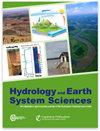The Wetland Intrinsic Potential tool: mapping wetland intrinsic potential through machine learning of multi-scale remote sensing proxies of wetland indicators
IF 5.8
1区 地球科学
Q1 GEOSCIENCES, MULTIDISCIPLINARY
引用次数: 2
Abstract
Abstract. Accurate, unbiased wetland inventories are critical to monitor and protect wetlands from future harm or land conversion. However, most wetland inventories are constructed through manual image interpretation or automated classification of multi-band imagery and are biased towards wetlands that are easy to directly detect in aerial and satellite imagery. Wetlands that are obscured by forest canopy, that occur ephemerally, and that have no visible standing water are, therefore, often missing from wetland maps. To aid in the detection of these cryptic wetlands, we developed the Wetland Intrinsic Potential (WIP) tool, based on a wetland-indicator framework commonly used on the ground to detect wetlands through the presence of hydrophytic vegetation, hydrology, and hydric soils. Our tool uses a random forest model with spatially explicit input variables that represent all three wetland indicators, including novel multi-scale topographic indicators that represent the processes that drive wetland formation, to derive a map of wetland probability. With the ability to include multi-scale topographic indicators that help identify cryptic wetlands, the WIP tool can identify areas conducive to wetland formation while providing a flexible approach that can be adapted to diverse landscapes. For a study area in the Hoh River watershed in western Washington, USA, classification of the output probability with a threshold of 0.5 provided an overall accuracy of 91.97 %. Compared to the National Wetlands Inventory, the classified WIP tool output identified over 2 times the wetland area and reduced errors of omission from 47.5 % to 14.1 % but increased errors of commission from 1.9 % to 10.5 %. The WIP tool is implemented as an ArcGIS toolbox using a combination of R and Python scripts.湿地内在势工具:通过多尺度湿地指标遥感代理的机器学习绘制湿地内在势
摘要准确、公正的湿地清单对于监测和保护湿地免受未来的危害或土地转换至关重要。然而,大多数湿地清单是通过人工图像解译或多波段图像自动分类构建的,并且偏向于在航空和卫星图像中易于直接检测的湿地。被森林冠层遮蔽的湿地,转瞬即逝的湿地,没有可见的死水,因此,在湿地地图上经常会遗漏。为了帮助检测这些潜在湿地,我们开发了湿地内在潜力(WIP)工具,该工具基于地面上常用的湿地指标框架,通过水生植被、水文学和含水土壤的存在来检测湿地。我们的工具使用一个随机森林模型,该模型具有空间明确的输入变量,代表所有三个湿地指标,包括代表驱动湿地形成过程的新型多尺度地形指标,以得出湿地概率图。WIP工具能够包含多尺度地形指标,帮助识别隐藏湿地,从而识别有利于湿地形成的区域,同时提供一种灵活的方法,可以适应不同的景观。对于美国华盛顿西部Hoh河流域的一个研究区域,输出概率分类的阈值为0.5,总体准确率为91.97%。与国家湿地清单相比,分类WIP工具的输出识别了超过2倍的湿地面积,将遗漏误差从47.5%减少到14.1%,但将委托误差从1.9%增加到10.5%。WIP工具是使用R和Python脚本的组合作为ArcGIS工具箱实现的。
本文章由计算机程序翻译,如有差异,请以英文原文为准。
求助全文
约1分钟内获得全文
求助全文
来源期刊

Hydrology and Earth System Sciences
地学-地球科学综合
CiteScore
10.10
自引率
7.90%
发文量
273
审稿时长
15 months
期刊介绍:
Hydrology and Earth System Sciences (HESS) is a not-for-profit international two-stage open-access journal for the publication of original research in hydrology. HESS encourages and supports fundamental and applied research that advances the understanding of hydrological systems, their role in providing water for ecosystems and society, and the role of the water cycle in the functioning of the Earth system. A multi-disciplinary approach is encouraged that broadens the hydrological perspective and the advancement of hydrological science through integration with other cognate sciences and cross-fertilization across disciplinary boundaries.
 求助内容:
求助内容: 应助结果提醒方式:
应助结果提醒方式:


